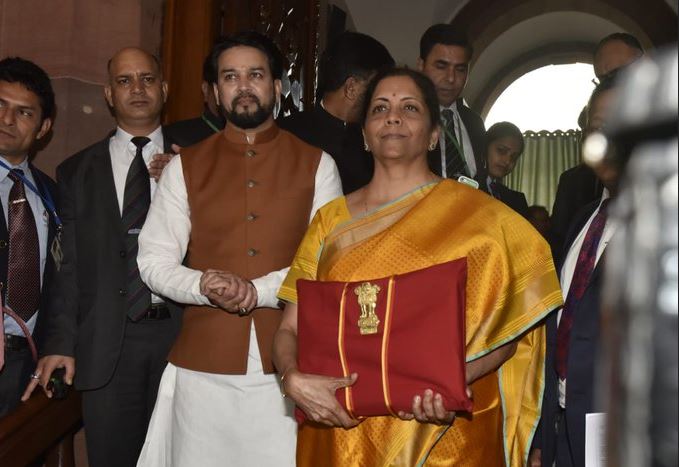India's health insurance in COVID times. Will Budget have a fix? – The Federal

All eyes are on how Finance Minister Nirmala Sitharaman will tackle healthcare, a critical sphere of national spending
Nirmala Sitharaman with Minister of State for Finance Anurag Thakur last year | Photo: ANI/Twitter
Ahead of the Union Budget, all eyes are on how Finance Minister Nirmala Sitharaman will tackle healthcare, a critical sphere of national spending whose importance has only been magnified by the coronavirus pandemic. Most pre-budget wishlists from the healthcare industry have called for higher government spending on healthcare â arguing to even bring forward the 2025 target of reaching 2.5 per cent of gross domestic product (GDP) from the current 1.35 per cent that the government spends on health.
Higher government expenditure means the citizen spends less from his own pocket. Currently, India has one of the highest levels of out-of-pocket-expenditure (OOPE) in the world â about 63 per cent. The second wave of COVID framed that scenario even more starkly â high medical costs and low health insurance coverage.
Indeed, amid COVID, demand for health insurance has been growing â in the current fiscal year up to December, gross premium underwritten for health insurance grew 28 per cent to â¹54,235 crore, faster than other insurance segments.
How then does the macro picture of healthcare stack up? Hereâs an explainer in five graphs:
Advertisement
Existing health insurance schemes â such as government-subsidised schemes (like Ayushman Bharat), social health insurance schemes (like Employees State Insurance Scheme) and private voluntary schemes â potentially target 70 per cent of the population. However, actual coverage is lower. This is either because of overlap between different schemes or because government-subsidised schemes donât yet cover all eligible households.
But while government-subsidised schemes cover the poorest sections and private voluntary schemes cater to high-income groups, thereâs a large chunk in the middle thatâs currently not covered by any financial protection. In a report in October, the Niti Aayog estimated this âmissing middleâ to be at least 30 per cent of the population, or about 40 crore people.
âCurrently, in the absence of a low-cost health insurance product, the missing middle remains uncovered despite the ability to pay nominal premiums,â the report said, highlighting the need for designing a low-cost comprehensive health insurance product for this population segment.
As the report notes, most products in the private voluntary health insurance market cover hospitalisation but do not include outpatient benefits. âInclusion of outpatient benefits will curtail catastrophic health spending â the key objective of a health insurance product for the missing middle,â it said.
During 2020-21, about 51.47 crore people were covered by health insurance policies, according to the Insurance Regulatory and Development Authority of India (IRDAI). Over 66 per cent of them were covered under government sponsored health insurance schemes, about 23 per cent under group health insurance and 10.32 per cent under individual policies.
In the run-up to the budget, insurers have suggested that the government consider a reduction in GST applicable on health insurance premiums, which is currently at 18 per cent. This would make health insurance more affordable and encourage people to purchase additional top-up plans, insurers say.
In the previous fiscal year, general and health insurers settled 1.40 crore health insurance claims and paid â¹43,355 crore towards settlement of claims.
During the subsequent severe second wave of COVID infections last May, the rise in hospitalisations saw a steep increase in claims, according to reports.
âThe advent of the pandemic has changed the perception of people towards health insurance and made people realise its importance in the current scenario by safeguarding oneself and family against rising medical expenditure,â says Krishnan Ramachandran, CEO and MD of Niva Bupa Health Insurance Company. âThe current rise in the COVID cases leading to increase in claims has put great stress on the sector, yet it has been standing tall against all the headwinds.â
Better product innovation, use of technology and re-focussing on distribution models are some of the ways to tackle the challenge of low awareness and penetration, he says. âThe buying capacity of health plans is low in India. The rise in the growth rate of adoption that was witnessed last year due to the pandemic seems to be slowing as life is slowly returning to normal,â says Ramachandran. But high demand for health insurance from Tier 2 and 3 markets can also be seen in India, he says. âToday, more women and millennials are taking a keen interest in purchasing financial tools like insurance.â
 In India, almost 60 per cent of all hospitalisations and 70 per cent of outpatient services are delivered by the private sector, the Niti Aayog report pointed out, citing NSSO data.
A glimpse of how overall healthcare expenditure in the country is stacked up comes from the National Health Accounts. The metric used for this is Current Health Expenditures (CHE) which includes all the operational expenditure on healthcare net of capital expenditure.
Broadly, primary and secondary care accounts for more than 80 per cent of current government health expenditure, according to the National Health Accounts for 2017-18, which were released in November. When it comes to tertiary care, private sector expenditure is higher than government spending.
 The National Health Accounts for 2017-18 estimate government expenditure on health at 1.35 per cent of GDP.
The stated goal is to increase government health expenditure to 2.5 per cent of GDP by 2025 and to also decrease the proportion of households facing catastrophic health expenditure by 25 per cent from current levels by 2025.
According to the previous yearâs Economic Survey, an increase in public health expenditure from current levels in India to 3 per cent of GDP can reduce out-of-pocket expenditure by half â from 60 per cent currently to about 30 per cent.Â







